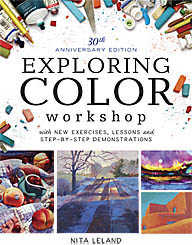Revisiting the Golden Mean
Not having a scientific bent, I've never tried to analyze the whys and wherefores of the Golden Mean, but I have read that in design tests, this proportion is almost invariably selected by subjects as the most pleasing proportion of a rectangle. It is found in nature (for example, a chambered nautilus) and was used in art by the Greeks and some Renaissance artists. It has always been a mystery to me why watercolor paper manufacturers don't make their standard sheets in this proportion. A half sheet (15 x 22")of Imperial size (22 x 30") is about as close as you can get. I don't think thirds" cuts it. More like 3:5 or 5:8.
Here are a couple of ways to find the "ideal" location for a focal point,
regardless of the dimensions of your surface. One is the "rule of thirds," which divides the surface in thirds each way and places the focal point at any intersection of lines. Another is "rabatment," which consists of drawing diagonals from corner to corner, then drawing a perpendicular line from any corner to a diagonal. See this diagram on my Web site FAQ page. (Scroll down to diagram.)Both methods provide four "sweet spots" to choose from as your focal point, each spot being a different measure from every edge of the paper or canvas.
Another interesting way to divide your space is shown in an my earlier design tools blog.
Ed Whitney always said to locate your center of interest a different distance from all four sides. That's it in a nutshell. Although don't hesitate if you find a good reason to put it smack-dab in the middle.
Here are a couple of ways to find the "ideal" location for a focal point,
regardless of the dimensions of your surface. One is the "rule of thirds," which divides the surface in thirds each way and places the focal point at any intersection of lines. Another is "rabatment," which consists of drawing diagonals from corner to corner, then drawing a perpendicular line from any corner to a diagonal. See this diagram on my Web site FAQ page. (Scroll down to diagram.)Both methods provide four "sweet spots" to choose from as your focal point, each spot being a different measure from every edge of the paper or canvas.
Another interesting way to divide your space is shown in an my earlier design tools blog.
Ed Whitney always said to locate your center of interest a different distance from all four sides. That's it in a nutshell. Although don't hesitate if you find a good reason to put it smack-dab in the middle.





1 Comments:
The golden mean. . . isn't math just remarkable? And difficult for me. I try to use it, "the rule of thids" anyway. Thanks for your explanation of the rabatement and the grid.
Post a Comment
<< Home